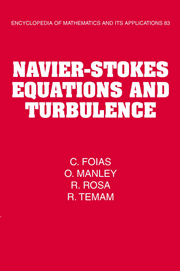Book contents
- Frontmatter
- Contents
- Preface
- Acknowledgments
- Chapter I Introduction and Overview of Turbulence
- Chapter II Elements of the Mathematical Theory of the Navier–Stokes Equations
- Chapter III Finite Dimensionality of Flows
- Chapter IV Stationary Statistical Solutions of the Navier–Stokes Equations, Time Averages, and Attractors
- Chapter V Time-Dependent Statistical Solutions of the Navier–Stokes Equations and Fully Developed Turbulence
- References
- Index
Chapter V - Time-Dependent Statistical Solutions of the Navier–Stokes Equations and Fully Developed Turbulence
Published online by Cambridge University Press: 14 August 2009
- Frontmatter
- Contents
- Preface
- Acknowledgments
- Chapter I Introduction and Overview of Turbulence
- Chapter II Elements of the Mathematical Theory of the Navier–Stokes Equations
- Chapter III Finite Dimensionality of Flows
- Chapter IV Stationary Statistical Solutions of the Navier–Stokes Equations, Time Averages, and Attractors
- Chapter V Time-Dependent Statistical Solutions of the Navier–Stokes Equations and Fully Developed Turbulence
- References
- Index
Summary
Introduction
This long and technical chapter aims at providing some basic connections between the mathematical theory of the Navier–Stokes equations (NSE) and the conventional theory of turbulence. As stated earlier, the conventional theory of turbulence (including the famous Kolmogorov spectrum law) is based principally on physical and scaling arguments, with little reference to the NSE. We believe that it is instructive to connect turbulence more precisely with the Navier–Stokes equations.
It is commonly accepted that turbulent flows are necessarily statistical in nature. Indeed, if a flow is turbulent, then all physical quantities are rapidly varying in space and time and we cannot determine the actual instantaneous values of these quantities. Instead, one usually measures the moments, or some averaged values of physical quantities; that is, only a statistical description of the flow is available. The first task in this chapter is to establish, in a more precise way, the time evolution of the probability distribution functions associated with the fluid flow – that is, the statistical solutions of the Navier–Stokes equations. Although the discussion is relevant to deterministic data (initial values of the velocities and volume forces), we extend our discussion to the case of random data; however, we will not examine the more involved case of very irregular forcing (such as white or colored volume forces), since deterministic or moderately irregular stochastic data suffice, in practice, to generate complex turbulent flows.
Information
- Type
- Chapter
- Information
- Navier-Stokes Equations and Turbulence , pp. 255 - 330Publisher: Cambridge University PressPrint publication year: 2001
